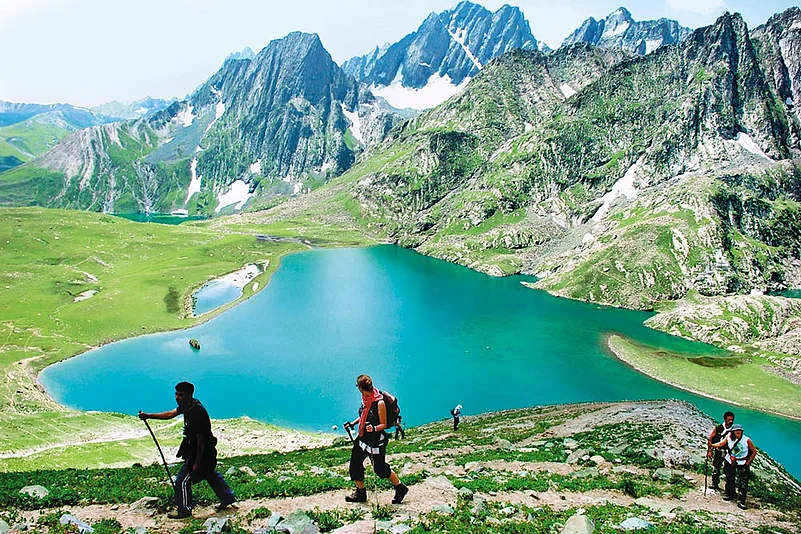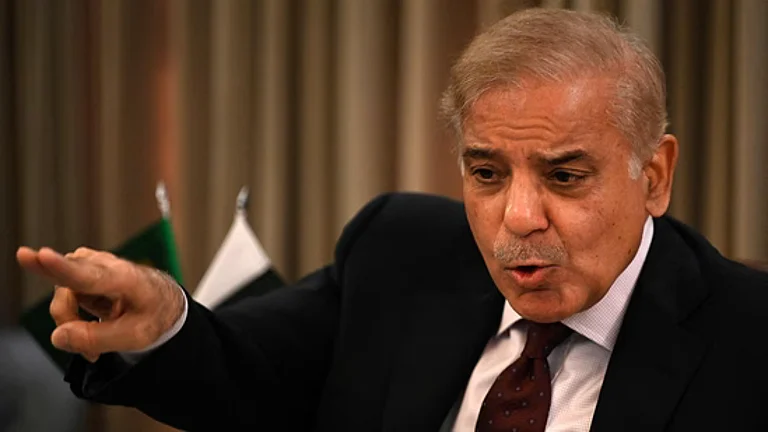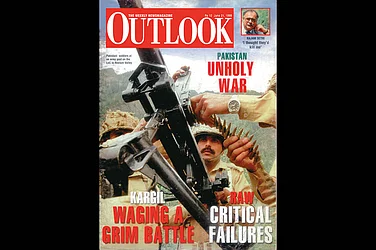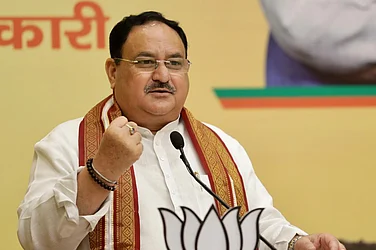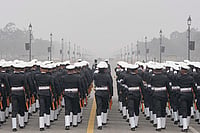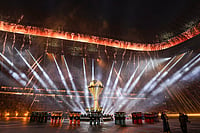September 7 was a good day for the trekkers, they had successfully summitted the Kolahoi peak of Kashmir. Among the contingent was 27-year-old Adil Shah, a mountaineer of repute. They began descending on the same day. Adil called Mehmood Ahmad Shah, president of the J&K Mountaineering and Hiking Club (MHC), just to inform him that the group, comprising nine people, were making their way down. The growing trekking trend among Valley locals has made Kolahoi a popular project. But it’s a challenging peak, even for skilled mountaineers. That’s why Mehmood, an avid trekker himself, asked Adil to be cautious.
After a few hours of that call, Mehmood heard the news that two mountaineers had met with an accident while negotiating a crevice at Kolahoi. One of them was Adil and the other Naveed Jeelani, a junior officer of the Kashmir administrative services.
Riyaz Ahmad Lone, a trekker who runs an adventure tour company in Pahalgam, from which Kolahoi is just 26 km, says he took five of his colleagues along for a rescue when he heard the news. The police, the J&K disaster management authority and the state’s tourism department also rushed their teams to Kolahoi. “We reached Kolahoi base camp at Danwat at around 2 am on September 8. At around 4 am, we saw locals of the area carrying an injured trekker, Haziq Beig, whom they had rescued from the glacier. He was airlifted to Srinagar.” The next day, when the visibility became better, Lone’s group and other rescue teams trekked towards the spot of the incident and found the two bodies, which were also flown to Srinagar.
Officials say a ‘lapse of judgement’ might have led to the two young trekkers losing their lives as the expedition team started to descend when the sun came out that day. From afar, Kolahoi looks like a granite rock, the snow spread thinly on its steep, angular faces. It doesn’t retain much snow due to these gravity-defying slopes and a rise in temperature can lead to falling rocks. The group of trekkers included businessmen, bankers and government officials from Kashmir who had taken the week off to summit the peak. One of the survivors from the team, 29-year-old banker Zahoor Baba, says the expedition was planned thoroughly. “We were all trained mountaineers and were well equipped. It was not that we just stepped out of our homes to summit a peak like Kolahoi! The accident happened only when we were nearing the base camp,” says Baba.
Mehmood says Adil was one of the finest among the Kashmiri trekkers of this generation. He had established his own trekking company and had climbed most peaks in J&K. He is said to have discovered the highest alpine lake, at an altitude of 4602 meters, around Sonmarg. But climbing technical peaks is always a risky affair, even for skilled mountaineers like Adil.
What then of scores of Kashmiri amateur trekkers who have been attempting to scale peaks like Kolahoi! The latest trend of trekking tends to bypass the safety measures at times. “I have seen Kashmiri youths with no previous training going to Kolahoi,” says Lone. Trekking companies insist local youths should opt for training at MHC or the Jawahar Institute of Mountaineering and Winter Sports near Pahalgam before venturing on big treks.
As per the new IMF guidelines, trekkers do not need permission to climb the 17,770 ft tall Kolahoi. But it’s not just about the height. Rouf Tramboo, a veteran Kashmiri trekker, says that Kolahoi, with all its ridges and crevices, needs some training to scale.
Tramboo believes that the death of these two mountaineers will for once make Kashmiris, who have started going for trekking in large numbers of late, reflect on the risks involved. Sitting at his desk in his office at Boulvard road overlooking Dal Lake, Tramboo, 58, says the incident will impact local adventurers as the families of amateur trekkers will be over cautious now. Having widely trekked in the Himalaya in J&K and Nepal since 1984, Tramboo, who runs a trekking company, sheds light on the current trekking scenario in Kashmir. “Any trekking route in Kashmir is less than two hours travel from Srinagar airport. That makes Kashmir an ideal destination for trekking. However, in the absence of tourists, especially foreigners who visit in much less numbers now due to travel advisories, local youth have taken to adventure tourism like never before. The trekking companies of the state would see in them future climbers and guides. We hope they continue to scale mountains,” says Tramboo.
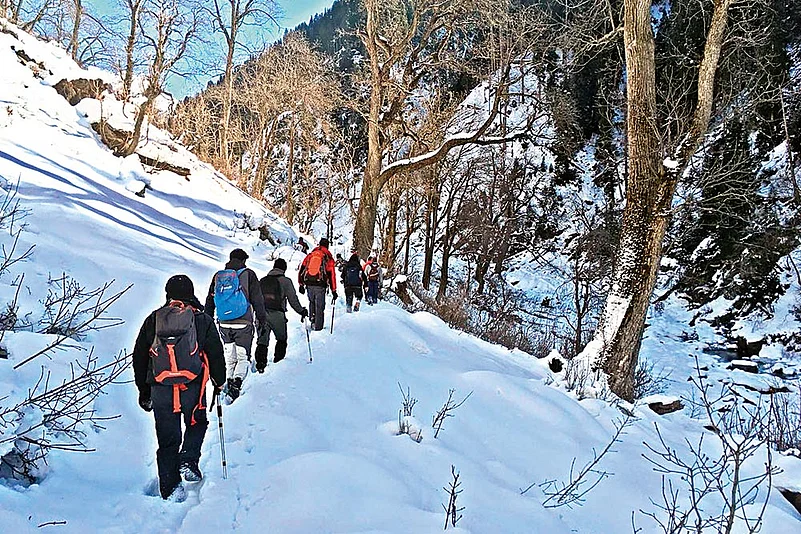
Kashmiri trekkers in Sonmarg area
Former Director General of Tourism Saleem Beg recalls that after the insurgency in 1990s mountains, especially in north Kashmir, were closed for locals by the security forces. “But in South Kashmir, youngsters would go for trekking on their own,” says Beg. The local interest around trekking caught on from 2004-2005 and since then, several locals have been trekking in different mountain ranges in the Valley. “I saw a group of young people in the higher reaches of Pahalgam a decade ago. I was surprised as they were all shopkeepers and had no equipment, except trekking boots and they were planning to trek the glacier,” adds Beg.
Sajad Shah, 37, who runs a furniture business in the uptown area of Konakhan, says he is a regular trekker. “We go for trekking every year. We are eight people, all businessmen.” Shah started without any training, but he then got training from the MHC.
Trekking is also a newfound passion among the doctors at the Valley’s Sheri Kashmir Institute of Medical Sciences (SKIMS). Dr Imran Hafeez, interventional cardiologist, at SKIMS, says he and his colleagues take out time for their passion from their busy schedule. In 2015, Dr Hafeez, along with other doctors and technicians, came up with the SKIMS hikers and trekkers Group.
The doctors’ trekking pictures on social media get much attention. “People ask us whether such places exist in Kashmir. We ourselves didn’t know anything about these places and the warmth of mountain villages,” says Hafeez.
The consistency of interest in trekking has also brought in new initiatives. Abdul Basit, 22, opened his own camping and mountaineering company in 2017 that provides logistical support to women trekkers and campers. He lives in Carari Sharief, a small town on the route to Yusmarg, another popular destination. “I wanted to curate a safe space for girls. So I started this in late 2017,” Basit says. “This year we had three girl groups from Kashmir. The number is not great but at least a message is going out to parents. The situation in Kashmir is such that we can’t blame the families for not letting their children, especially girls out. But with our efforts, we are trying to change it. There is conflict, death and chaos but we can’t stop living,” he adds.
By Naseer Ganai in Srinagar






